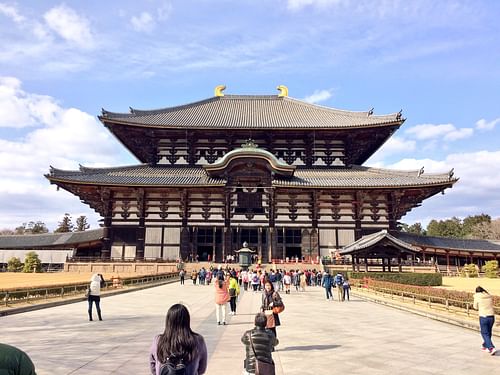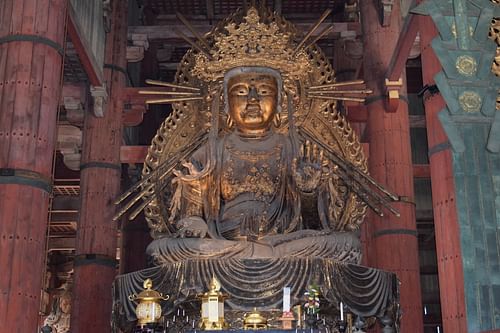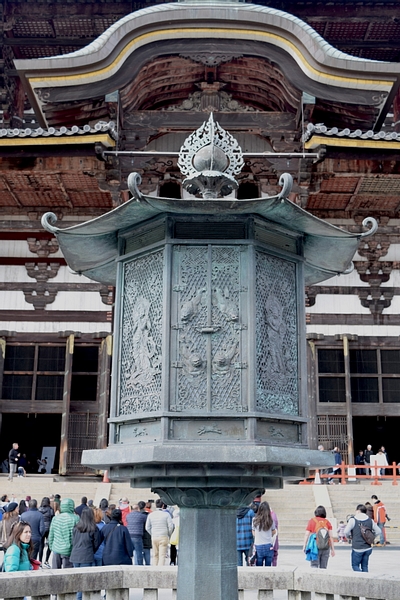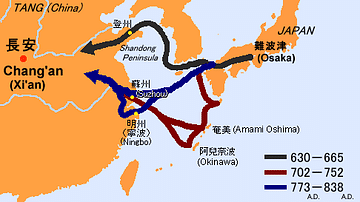
Todaiji is an ancient temple complex in Nara, Japan. Founded in 738 CE and officially opened in 752 CE when Nara was the capital, the temple is the headquarters of the Buddhist Kegon sect. The temple has a 500-ton sculpture of the Buddha, best known in Japan as the Nara Daibutsu, which is the largest bronze statue in the world, housed in the largest wooden building in the world. Todaiji is also home to thousands of precious art objects and a UNESCO World Heritage Site.
Daibutsuden
The Buddhist temple of Todaiji in Nara was originally commissioned by Emperor Shomu (r. 724-749 CE) but was not actually opened until 752 CE. The complex would not be entirely finished until 798 CE. It stood to the east of the imperial palace, hence its name 'Great Eastern Temple'. The purpose of the Todaiji was to act as the headquarters of a nationwide network of temples and become the Buddhist protector of the state. It, thus, became, too, a centre of learning and study with a college and libraries where sutras were translated. In addition, and typical of the synergy between Buddhism and the native Shinto religion in ancient Japan, the shrine at Usa sent an image of Hachiman, Shinto god of war and culture, with great ceremony to Todaiji so that the god's spirit of kami could become the protector of the new sacred site.
The Todaiji complex once covered 16 blocks of the city but was partially destroyed in a fire during the Genpei War (1180-1185 CE). The destruction was deliberate and carried out by the Taira clan as retaliation for the temple's monks interfering in politics and materially supporting their great rivals the Minamoto clan. Fortunately, it was restored to its former glory in 1195 CE by the victorious Minamoto, albeit on a slightly smaller scale than the original. Such was the size of the buildings that the project, along with the building of other lavish temple sites across the country, almost bankrupted the Japanese state.
The star building is the Great Buddha Hall or Daibutsuden. The current version of the Great Hall, which dates to the Edo Period (1603-1867 CE) following an earthquake in 1709 CE, is an impressive 57 metres (187 ft) long and 48 metres (157 ft) high making it the largest wooden building in the world. The original Great Hall was even grander, around one-third bigger, although the height was the same. The present roof has 110,000 15-kg tiles and a gold kite's tail (shibi) at either end of the ridge-pole.
The Buddha Statue
The Daibutsuden has to be big because it contains a 15-metre (49 ft) high cast bronze statue of a seated Buddha, the largest such statue in the world and weighing in at around 500 tons. It is a representation of Dainichi Nyorai (aka Birushana, Roshana Butsu or Vairocana), most important deity of the Kegon sect, with his right hand raised in the gesture of teaching. The sculpture was made on the wishes of Emperor Shomu who wanted to reverse the effects of the devastating outbreak of smallpox which had hit in 737 CE. Such a gesture would also be a useful shove up the path towards enlightenment, and so Shomu made the following declaration to his people:
…We wish to make the utmost use of the nation's resources of metal in the casting of this image, and also to level off the high hill on which the great edifice is to be raised, so that the entire land may be joined with Us in the fellowship of Buddhism and enjoy in common the advantages which this undertaking affords to the attainment of Buddhahood.
It is We who posses the wealth of the land; it is We who posses all power in the land. With this wealth and power at Our command, We have resolved to create this venerable object of worship. The task would appear to be an easy one, and yet a lack of sufficient forethought on Our part might result in the people's being put to great trouble in vain, for the Buddha's heart would never be touched if, in the process, calumny and bitterness were provoked which led unwittingly to crime and sin.
Therefore all who join in the fellowship of this undertaking must be sincerely pious in order to obtain its great blessings, and they must daily pay homage to Lochana Buddha, so that with constant devotion each may proceed to the creation of Lochana Buddha. If there are some desirous of helping in the construction of this image, though they have no more to offer than a twig or handful of dirt, they should be permitted to do so. The provincial and county authorities are not to disturb and harass the people by making arbitrary demands on them in the name of this project. This is to be proclaimed far and wide so that all may understand Our intentions in the matter. (Mason 47-48)
The audacious scale of the sculpture is best indicated by the measurement of some of its parts: the ears are 2.5 metres (8 ft) long, and the eyes are 1 metre (3 ft) wide. The Buddha's hair is rendered using 966 bronze spheres. The figure was originally covered in gold - then recently discovered in the Mutsu province - and must have been an awe-inspiring site to the faithful when it was unveiled in a ceremony attended by 10,000 people, including the entire imperial court, foreign dignitaries and monks from China and India.
Due to significant fire and earthquake damage over the centuries, the great Buddha statue has been partially restored several times. The most serious damage was the loss of the head during an earthquake in 855 CE, but the legs and lotus petal base are entirely original. On either side of the Buddha stand large gilded statues of bodhisattvas. On the right is the figure of Kokuzo Bosatsu, the patron deity of memory and wisdom, which dates to 1709 CE.
Other Buildings
Other buildings at Todaiji include the Nandaimon (Great South Gate), rebuilt in 1195 CE, with its two 8-metre high (26 ft) figures of Nio guardians. Carved in wood, they were added in 1203 CE and are typical of Heian Period sculpture. There is the Shoro (Belfry), which has the second largest bell in Japan, the Nigatsudo (Second Month Hall), and the Hokke-do (Third Month Hall or Lotus Hall), which still has original portions dating to the 8th century CE. Inside the Hokke-do are many fine Buddhist statues, the most famous being a 3.6-metre tall (12 ft) representation of an eight-armed Buddha with a large black pearl set in his forehead to represent the all-seeing third eye.
The Shoso-in (Treasury) contains over 9,000 sacred art objects, relics, furniture, ceramics, glassware, textiles, masks, mirrors, musical instruments, and weapons. Many come from India and China and include gifts given to the temple by emperors and empresses. There were also two 100-metre (328 ft) tall pagodas, and it was said that only the pyramids of Egypt were taller. Unfortunately, both were destroyed by an earthquake and never rebuilt. A large bronze octagonal lantern is still standing in the centre of the wide pathway between the Daibutsuden and Chumon Gate and dates to the founding of the temple. Behind the Daibutsuden is the Mirror Pond or Kagami-ike which offers the picturesque reflections of graceful architecture seen so often at Japanese temple sites.
This content was made possible with generous support from the Great Britain Sasakawa Foundation.












